Art World
‘You Get One in 50 Great Moments’: A Sports Photog on What It Takes to Shoot the Olympics
Getty photographer Adam Pretty is a veteran of 12 Olympic Games.
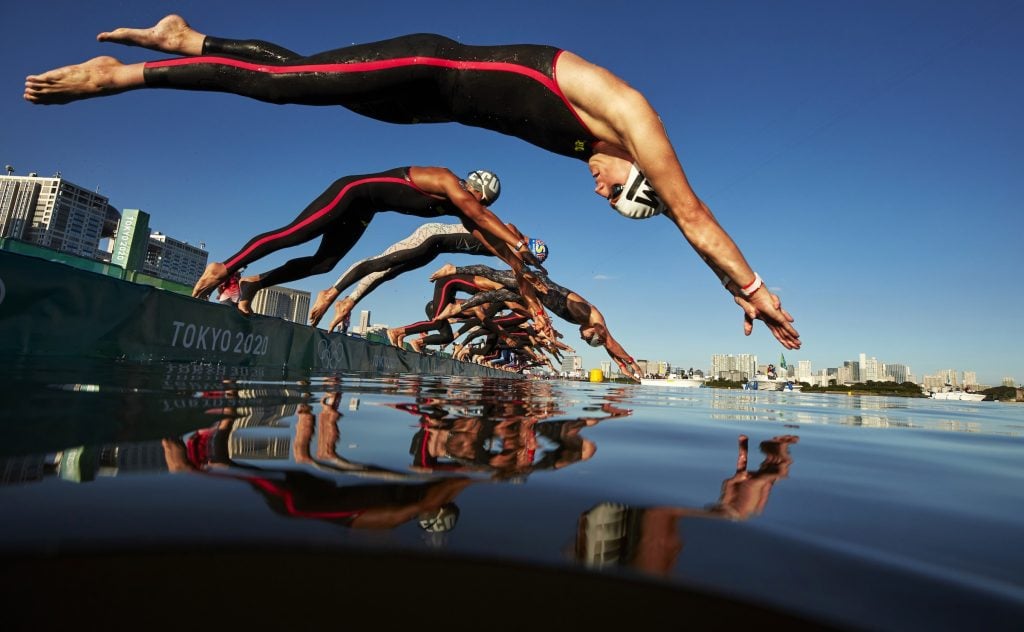
For the last two weeks, the eyes of the world were on Paris, as some 11,000 athletes from over 200 countries competed in the 2024 Summer Olympics. Documenting it all was a veritable army of photojournalists, led by a team of 60 editorial photographers from Getty Images, the official photographic agency of the International Olympic Committee.
It’s the photographers who create the lasting images of the games, working tirelessly to capture every event. Australian photographer Adam Pretty, age 47, has been part of that team for almost every Olympics since 2000 (he only missed Vancouver in 2010), as well as traveling extensively to different sporting events throughout the year.
This Olympics, there were 32 sports being contested in 38 venues not only across Paris, but in Nantes, Marseille, and Châteaurou, as well as the Tahitian village of Teahupo’o. Pretty, who has called Munich home for the last decade, spent much of the 2024 games covering the water events at the Aquatics Center and the La Defense Arena.
During a brief break between a round of diving and the final for artistic swimming, where the U.S. took silver, Pretty spoke with me about the grueling experience of shooting the 16-day event, the exhilaration of getting that perfect shot, and the technology that helps makes it all happen.
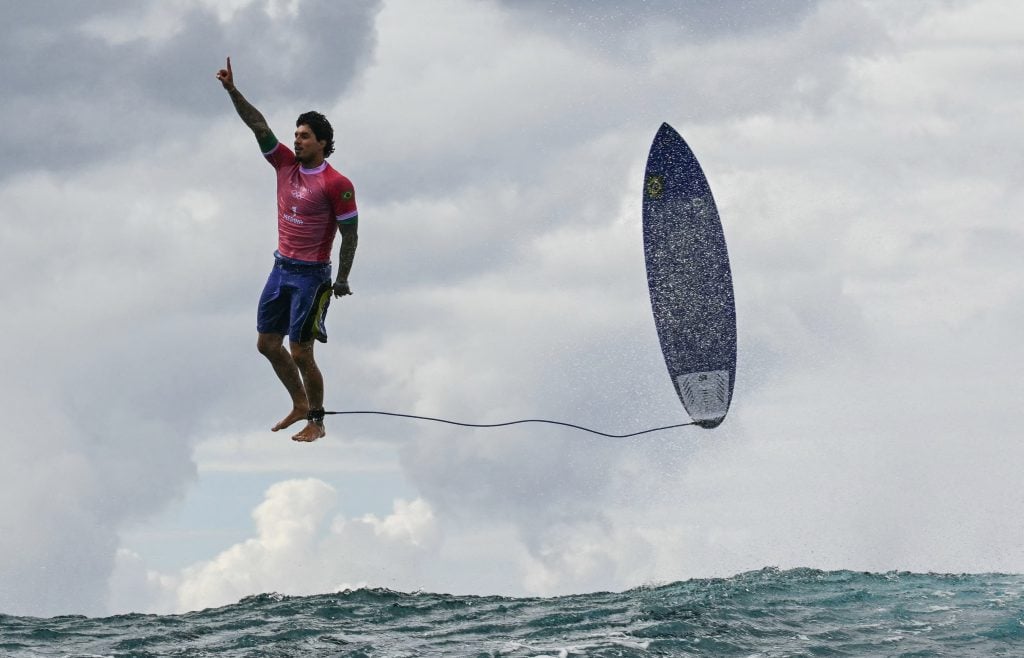
One of the most recognizable photographs from the 2024 Paris Olympic Games was this shot of Brazil’s Gabriel Medina reacting after getting a large wave in the men’s surfing competition in Teahupo’o, on the French Polynesian Island of Tahiti. Photo by Jerome Brouillet/AFP via Getty Images.
How does Getty assign all the photographers to cover an event of this magnitude? I’m sure you have specialties that you develop over the years, but how do they dispatch everybody to get equal coverage on the ground?
Yeah, we all work together. There’s the aquatics team and we’ve got about six people on it pretty permanently. We’ll go through the schedule ourselves and work out who’s going to do underwater, who’s going to be on the finish line, who’s going to be on platform B on the other side of the the pool. And if you have any particular events you want to do, we take that into account as well.
How did you get into sports photography?
When I was at high school, I wanted to be an illustrator. I went to work experience for a week when I was about 15 years old, but the cartoonist had to go to Germany on emergency. I was obviously looking lonely in the office, and a photographer came out and said, “do you want to come and hang out with me?” So, I spent a week with him in the dark room, and going out on job. I fell in love with it. I set up a dark room in my mom’s laundry and just knew that’s what I wanted to do.
I went to university for two months, but then I got a job in a newspaper. It was the time when it was transitioning from film to digital. We’d still shoot negative or slide film, but then process and scan rather than print in the dark room.
Because I knew how to use a computer, I got a job scanning and optimizing images for printing. I became a photographer at the paper in 1997. Then All Sport, which became Getty Images in ’98, was looking for a photographer in Sydney. It was the perfect opportunity.
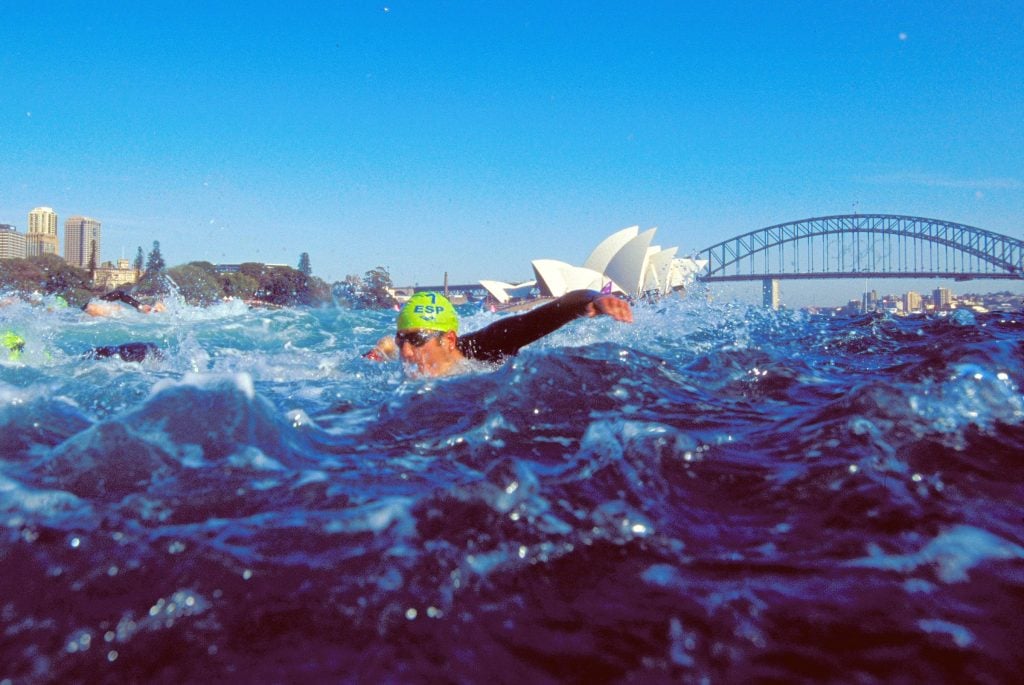
Competitors in action during the swim leg of the Men’s Triathlon at the Opera House during the 2000 Sydney Olympic Games. Photo by Adam Pretty/Allsport.
What was it like being part of that last generation of film photographers as the field transitioned to digital?
Sydney was the only Olympics I shot film. We had digital cameras, but they were so bad. I remember they said, “no, you have to use the digital.” But I shot the first day and it was so bad. I remember I rang my boss and said, “oh, my camera’s broken. I have to shoot film.” I think he knew I was not completely truthful, but I wanted get the best pictures I could, and the the digital camera wasn’t letting me do that.
What was it like shooting the Olympics on home soil?
It kind of made my career. I was just 21 years old. For the year before, I went crazy at all the test events. Absolutely every sports event came to town, so you could learn how to shoot Greco Roman wrestling, judo, badminton—whatever it might be. I managed to build up a really good portfolio.
And when the Olympics came, I was ready and knew what I was going to do. I had a bit of a leg up on everyone else!
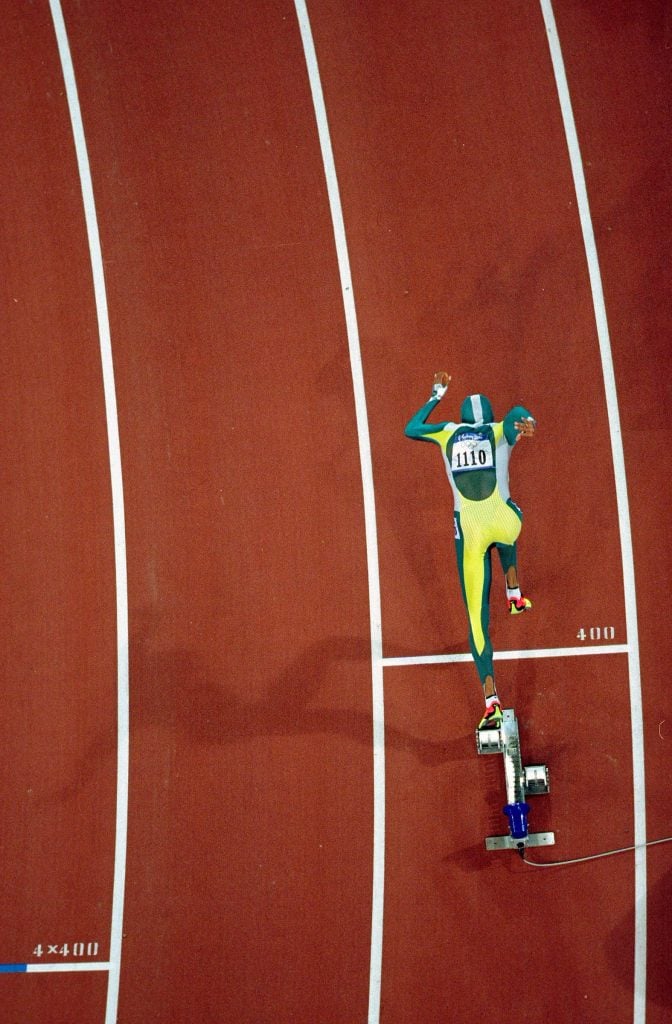
Cathy Freeman of Australia sets off on her way to gold in the womens 400 meter final at the Olympic Stadium on Day Ten of the 2000 Sydney Olympic Games. Photo by Adam Pretty /Allsport.
That must have been amazing. And now that its your 12th games, do you know how many different sports you’ve covered over the years?
No, I’ve got no idea—but I don’t think there’s much I’ve missed. In the early days, we used to do kind of everything. More recently, as that got unmanageable, I’ve specialized more in aquatic stuff, whether it be sailing or swimming. I shoot a lot underwater.
I assume you aren’t in the pool, so how does that work?
We have a new robotic camera for these Olympics. We operate it from the press seats or the pool deck, depending on where the venue allows us.
The camera is on the bottom of the pool, and we have a monitor with a live HDMI feed so we can see what we’re doing. It’s a stationary camera, but it’s got pan, tilt, and zoom. And then you can take pictures with a remote control.
This has been 20 years in the making. We finally got the robotics to a place where I can do what I want to do with it. It’s basically like having the camera in your own hands, the amount of control you have of over it. Before, they were often very clunky or unreliable, but now it’s at a level where it’s just an extension of your eye.
It’s a big technological advancement. In my first probably four or five Olympics, I just had a remote camera with a cable. You set it up day before, and hope the battery is okay. You shoot your roll of film, you dive down after, get it out, check your film, and hope there’s something on there. That was pretty stressful.
When digital came in, you could put a bigger card in so you could shoot maybe 500 pictures. Now we shoot directly to a laptop, and you can basically shoot as much as you want. For that last diving session, there were 28 divers, and I think I shot 2,700 pictures from the session. You can cover so much more now than you could before.
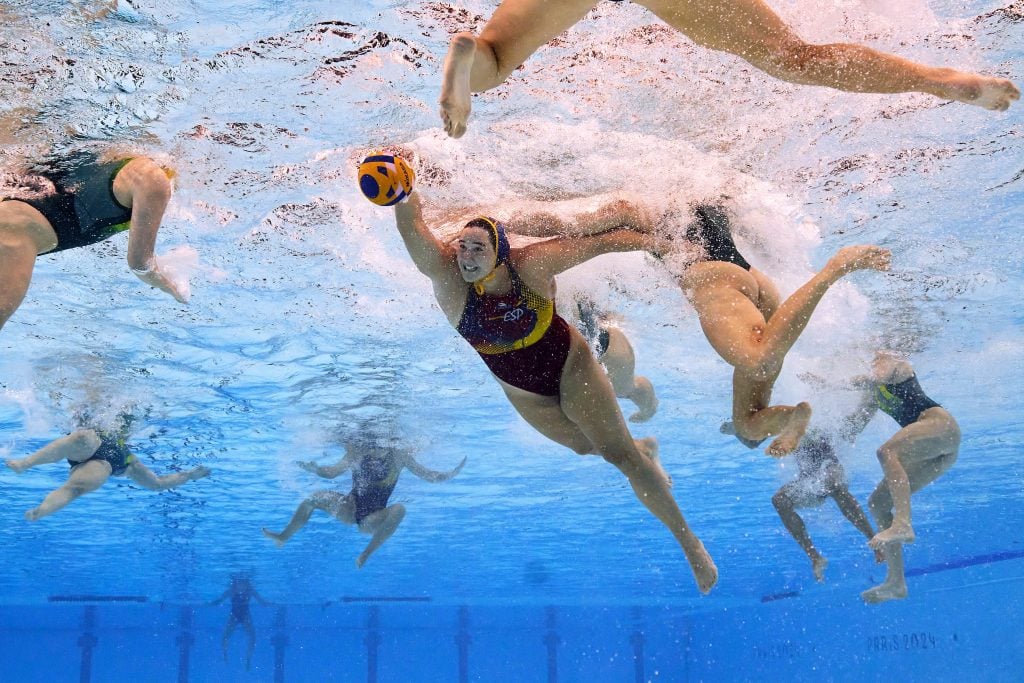
Adam Pretty used an underwater robotic camera to photograph Paula Leiton of Team Spain with the ball in the Women’s Gold Medal match between Team Australia and Team Spain on day fifteen of the 2024 Paris Olympic Games. Photo by Adam Pretty/Getty Images.
Wow! So you have 2,700 photographs to go through. How do you decide what to share with the world? And how do you process them?
They will come in with a little delay, maybe 10 seconds after I’ve shot them. I’ll view them in Capture One, which is an editing software. I’ll go through, tag a couple I like, and then just do a basic color grade. The photos go directly to our editing team in London, and they crop and caption.
What is your daily grind like as an Olympic photographer?
Today we left the hotel at 7:45, which was not too bad. Diving started at 10, so we set the underwater camera up in the morning. I’m shooting underwater all day. It’s pretty full on. And then by the time you finish editing, you won’t be back at hotel till you know, after 11—midnight for the swimming. It’s like a marathon.
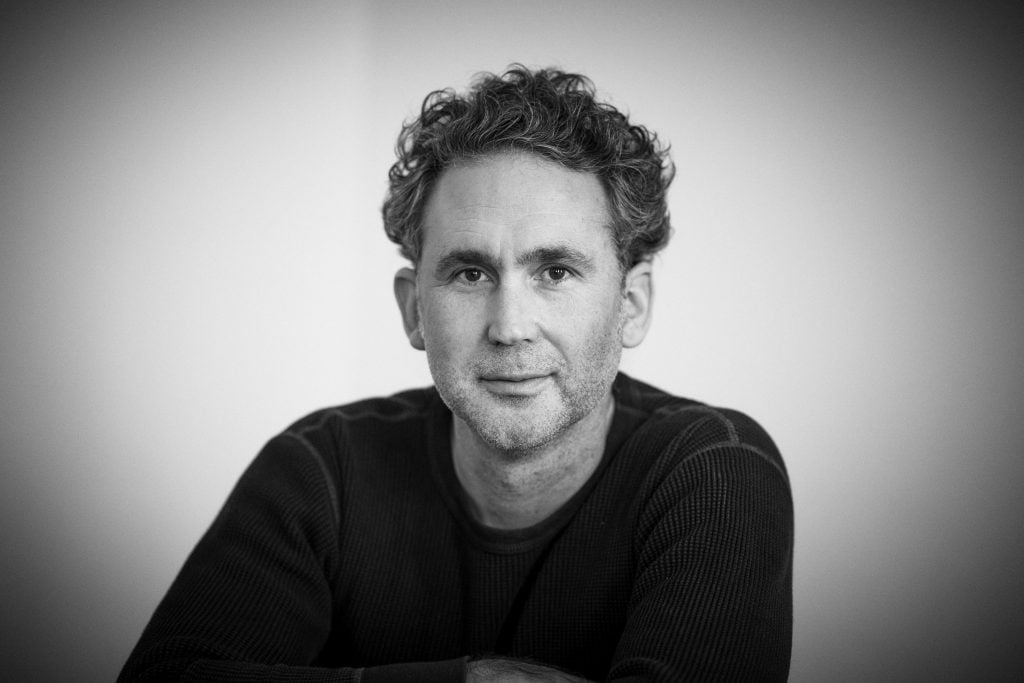
Adam Pretty. Photo courtesy of Adam Pretty.
I know it’s a collaborative effort with the other staff photographers. But do you ever feel a bit of competition to make sure that you get the best shot?
Oh yeah. I mean, it’s friendly competition. If someone gets a great shot, I’ll tell them. But you want to get the best picture at that event. And if someone nails it and you don’t, it hurts. But that’s what you use for motivation to try harder the next day.
When you’re 10 days into it, everyone’s really, really tired. And you’ve got to keep pushing yourself, and go out and make a make a good picture. The Olympics is probably the most competitive sports photography environment on earth. It’s the best photographers who shoot sports all come together. You’ve got to bring your best ideas, your your best form, and try and stand out. That’s why I love it.

Michael Phelps of the United States leads Chad le Clos of South Africa in the Men’s 200m Butterfly Final at the Rio 2016 Olympic Games. Photo by Adam Pretty/Getty Images.
When everything moves so fast, how do you try to predict where you need to be to get that shot?
A lot of it is experience. But the unpredictable moments, they’re often the best. So, you’ve got to be ready for everything—but when you do miss those moments, don’t go down a hole and get negative.
Yesterday at the water polo, the Australian team was celebrating at the far end of the pool. So, I picked up the long lens to shoot them, but then this one woman jumped up on the platform right in front of me and screamed and went crazy right in front of it. I missed a great picture right in front of me, just because I had the wrong lens on. It hurts a lot because it would have been a really nice picture. But then you have a little cry, go home, hopefully get some sleep, and come back again today and just try harder.
I don’t know what the odds are, but you probably get one in 50 great moments. You do miss a lot over the course of your career. You see a lot go past before you actually nail it when it is something super unexpected like that.
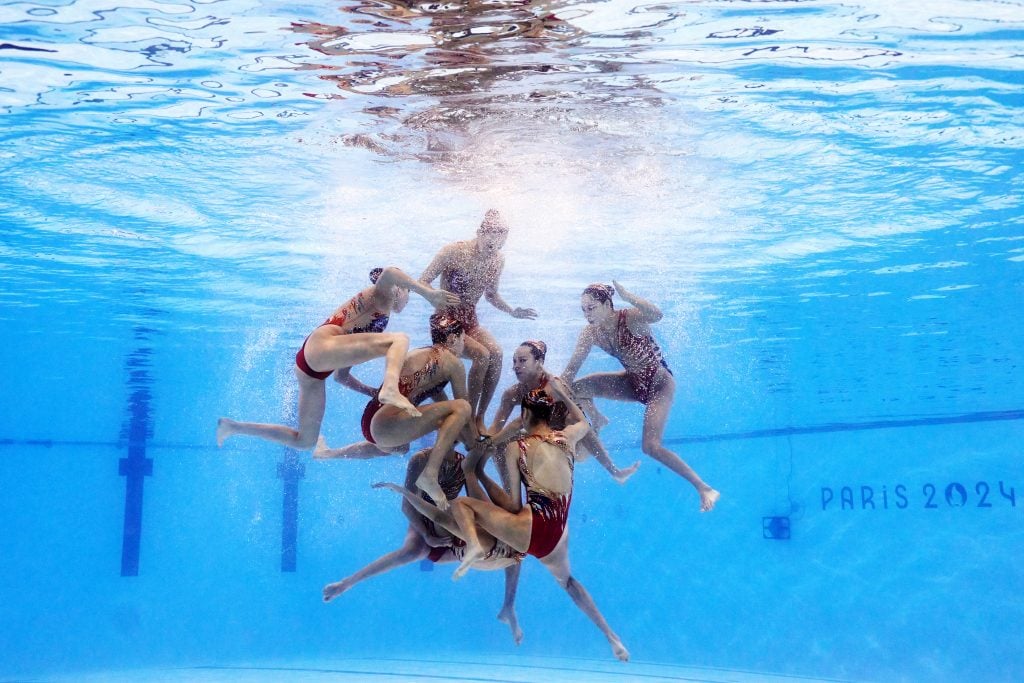
Adam Pretty used an underwater robotic camera to get this photo of China competing in the Team Acrobatic Routine in the 2024 Paris Olympic Games Paris. Photo by Adam Pretty/Getty Images.
What are you looking forward to as the games wrap up?
I’m really excited for the U.S. artistic swim team. They’re gonna do their final performance tonight. I made a little film with them before the competition and got to know them. And now they’re sitting in second place, which is amazing. So, if all goes well tonight, you know, they’ll get a medal and that will be phenomenal.
I don’t know if my pictures will do them justice. I’m on the underwater camera, and the water is a bit dirty in the pool now. It’s a little bit cloudy and foggy. But yeah, hopefully they smash it and end up in the medals, which will be exciting.
Wow! The pool is getting dirty? That’s kind of gross.
After a few days, with the filter system, if things have been done on the cheap or something, it just gets a bit cloudy. It affects your pictures a lot. It kills the clarity. You lose contrast, color, definition. It’s a little bit depressing. When you’re at the Olympics, you want everything to be perfect, but it happens. I mean, in Brazil the pool just turned bright green. It was disgusting. It looked like lime cordial. You basically couldn’t shoot anymore.
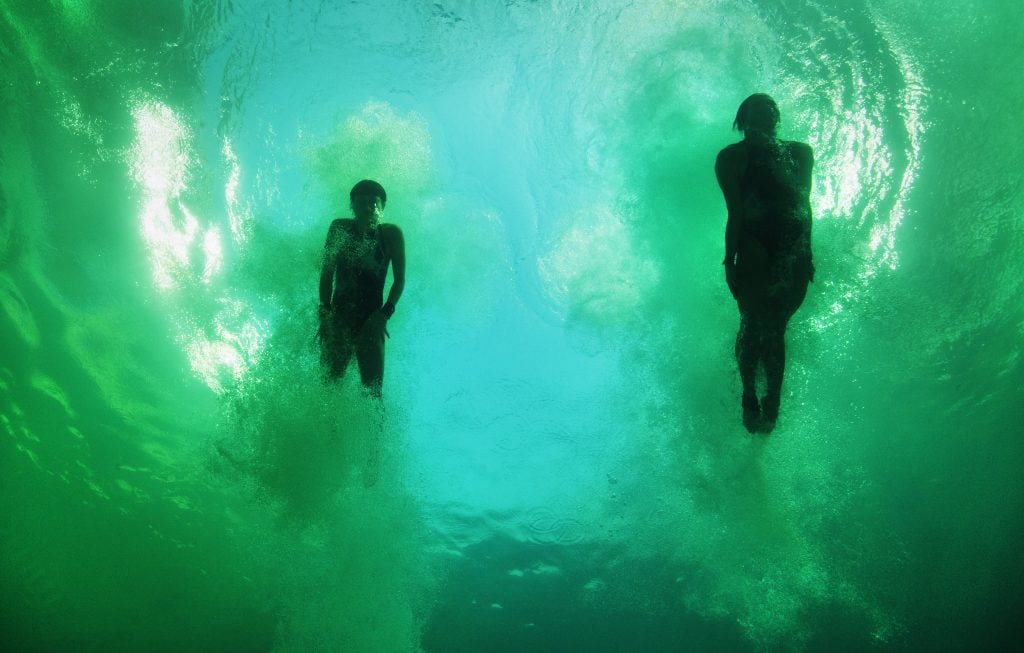
Kuk Hyang Kim and Mi Rae Kim of Democratic People’s Republic of Korea practice ahead of the Women’s Diving Synchronized 10 meter Platform Final at the 2016 Rio Olympic Games. The pool at the Maria Lenk Aquatics Centre turned green. Photo by Adam Pretty/Getty Images.
What are some of your favorite Olympic moments that you’ve documented and some some favorite photographs?
My first Olympics is probably still my favorite. It was my home Olympics, and everything was new and fresh. I’ve got great memories of it. Like [Indigenous sprinter] Cathy Freeman when she won the 400 meters. That was an amazing night. It was the best ever atmosphere at a sports event I’ve ever been to. It was 110,000 people screaming for her, and I was up in the roof shooting from above.
I also shot the start of the triathlon on the first day in Sydney Harbor, with the athletes swimming towards me, the Harbour Bridge and the Opera House in the background. So, that was like pretty iconic. It was used on the front page, kind of everywhere. From Tokyo, I’ve got a really cool dive in at the start of the triathlon, where the the athletes were almost mirrored on the surface of Tokyo Bay.
But pretty much every Olympics, I’ve got something I’m happy with. Every Olympics you go in with a few ideas that you want to achieve or or capture. When you nail something you’ve been you’ve been trying for for a long time, it’s super, super rewarding.
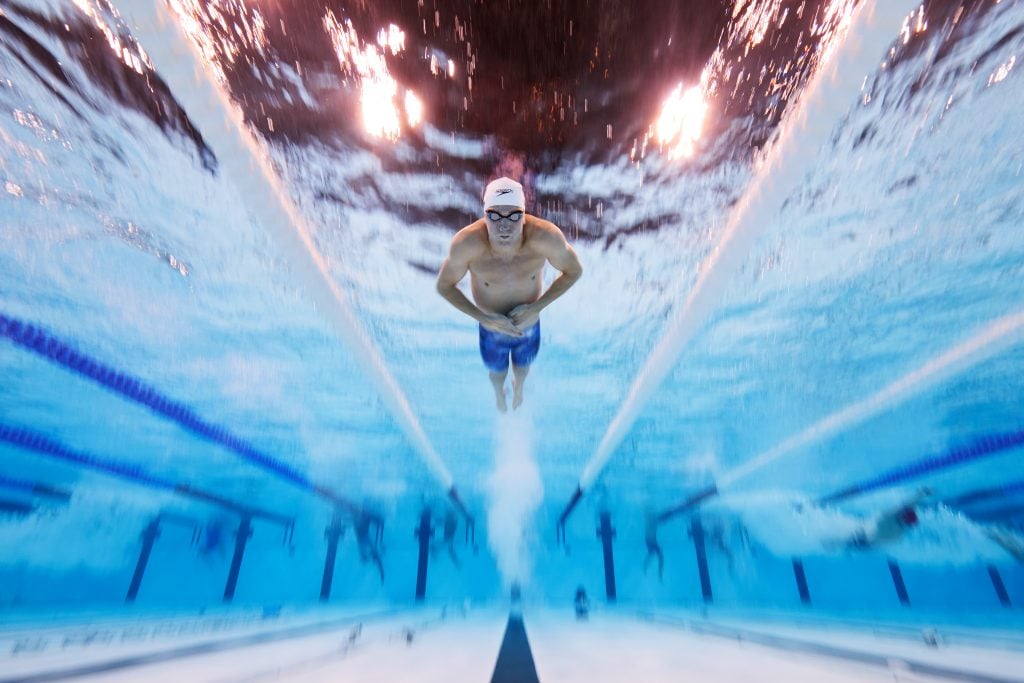
Adam Pretty used an underwater robotic camera to take this photo of U.S. swimmer Charlie Swanson competing in the Mixed 4x100m Medley Relay Heats at the 2024 Paris Olympic Games. Photo by Adam Pretty/Getty Images.
Do you find that the best photos necessarily capture the most important moments, or can you get a really beautiful photograph, even if it’s maybe not of the athlete who had the most exciting results?
One of my favorite pictures is from the relay qualification. The U.S.A. ended up winning, so it’s still a good story. But this was just a picture I wanted to try for a long time.
It’s a slow shutter speed picture of Charlie Swanson swimming breaststroke, coming up, and he looks kind of like a torpedo. The water in the background has gone a little bit otherworldly. It looks a little bit alien, almost. And he’s just floating through space. I managed to nail it, and I think it’s a beautiful picture.
The first day I was on. And I thought, [American swimmer] Katie Ledecky and [Australian swimmer] Ariarne Titmus, That was the story. That was a big rivalry. So, I set up the camera for a picture of those two off the dive. And the dive in was beautiful.
The Ledecky one was a bit more newsy, obviously. But it wasn’t super difficult to take that. The camera was stationary, whereas the other one I had to move the camera at the perfect speed. He needs to be doing the right thing. With underwater photography, you could do everything perfect as a photographer, but if the subject isn’t doing exactly what you need or is a bit off center, it just throws the whole composition off.
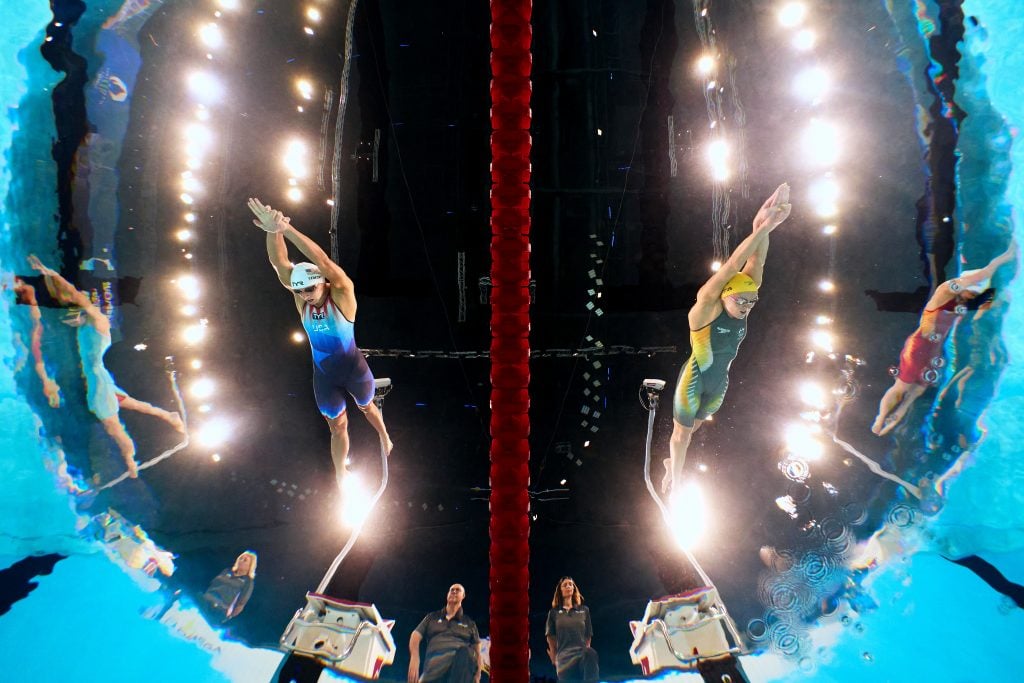
Adam Pretty used an underwater robotic camera to take this photo of American swimmer Katie Ledecky and her Australian rival Ariarne Titmus competing in the Women’s 400m Freestyle Heats on day one of the 2024 Paris Olympic Games. Photo by Adam Pretty/Getty Images.
The one image that people seemed to really be talking about from this games was the celebration from the surfer who got this massive wave. What do you think allows a photo to take on a life beyond just that one event?
It’s got a few different elements. The composition of that picture was was amazing, how the surfboard lined up with the athlete. He was almost standing on the cloud. That it was the Olympics probably helped as well. It’s a great picture. I would rather see someone on a wave, because I think that’s more of the event. But it’s those quirky moments that can capture the attention too.
What are the elements of a successful sports photo?
In sports photography, you need the composition perfect. You need the light perfect. The background, the canvas, has to be really nice and clean. When you do add up all those elements together, that’s when you get a good sports image.





